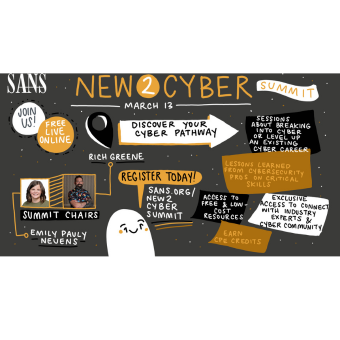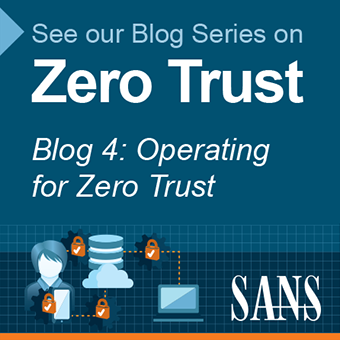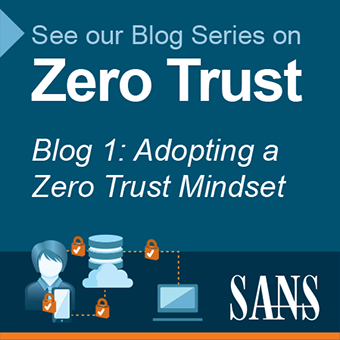Tags:

This is the third in a 4-part series of blogs covering the end-to-end aspects of zero trust.
Find the others here:
Blog 1: Adopting a Zero Trust Mindset
Blog 2: Architecting for Zero Trust
Blog 4: Operating for Zero Trust
Instrumenting for Zero Trust
The previous blog in this series introduced some fundamental architectural components associated with a Zero Trust approach to system security and access. Organizations that have a good handle on the location and types of architectural constructs needed to meet their unique Zero Trust needs are ready to start building and configuring to those designs. A large part of Zero Trust Architecture (ZTA) implementations involve the strategic use of purpose-built technologies that specifically address various zero trust components. Instrumenting an enterprise system to achieve specific ZTA objectives can be overwhelming. There is no shortage of tools and technologies touting their ability to deliver Zero Trust. This blog will provide some guidance on the types of technologies and tools that can be deployed across a well-architected system to deliver Zero Trust capabilities.
Mapping Zero Trust Architectures to Enabling Technologies
Upon developing a plan to achieve Zero Trust maturity and establishing an architecture aligned to the organization’s enterprise use cases – it is time to start implementing the appropriate enabling technologies. With so many technologies to choose from, a first step is analyzing potential technologies for each one’s ability to deliver the previously discussed ZTA components and how they integrate with each other. Those include the Policy Engine (PE), Policy Administrators (PA), Policy Decision Points (PDP), and multiple types of Policy Information Points (PIP). The table below aligns various technologies to the Zero Trust elements they support. These elements and capabilities may be delivered by single tools or a combination of tools.
| ZTA Component and Supporting Technologies | |
|---|---|
| Policy Engine (PE) | A Policy Engine (PE) handles the ultimate decision to grant, deny, or revoke access to a resource for a given subject - delivering continuous trust evaluations in a ZTA environment. |
| |
| Policy Administrator (PA) | A Policy Administrator (PA) executes the PE’s policy decision by sending commands to the Policy Enforcement Point (PEP) to establish and terminate the communications path between the subject and the resource. |
| |
| Policy Decision Point (PDP) | A Policy Decision Point (PDP) makes decision about whether or not to permit a subject to access a resource. A PDP consists of the combined activities of the PE and PA functions |
| |
| Policy Enforcement Point (PEP) | The Policy Enforcement Point (PEP) is a data plane component and guards the trust zone that hosts one or more enterprise resources. The PEP handles enabling, monitoring and eventually terminating connections between subjects and enterprise resources. |
| |
| Policy Information Points (PIPs) | Policy Information Points (PIP) collect and deliver important information derived through telemetry and logs generated by supporting components in a system. These include technologies and capabilities that each contribute uniquely to establish maturity. |
| Identity, Credential and Access Management (ICAM) | The ICAM PIP component includes the strategy, technology and governance for creating, storing, and managing subject (e.g., enterprise user) accounts and identity records and their access to enterprise resources. |
| |
| Endpoint Detection and Response (EDR)/Endpoint Protection Platform (EPP) | The endpoint protection PIP component includes the strategy, technology and governance to protect endpoints (e.g., servers, desktops, mobile phone, IoT devices and other non-human devices) and their data from threats and attacks as well as protect the enterprise from threats from managed and unmanaged devices. |
| |
| Data Security | The data security PIP component includes the policies an enterprise needs to secure access to enterprise resources, as well as the means to protect data at rest and in transit. Data security is a high priority item for government and commercial entities alike, with the government requiring FIPS-validated encryption for all data in transit and at rest in any systems that process federal data. |
| |
| Security Analytics | The security analytics PIP component encompasses all the threat intelligence feeds and continuous traffic/activity monitoring for a hybrid enterprise environment. This component gathers security and behavior analytics about the current state of enterprise assets and continuously monitors those assets to actively respond to threats or malicious activity. |
| |
Without knowledgeable implementation, configuration, and management of cybersecurity tools, those technologies can very easily fail to deliver the value they promise. In addition, cybersecurity tools are often complex and less-than-intuitive to operate. This makes it important to fully understand what capabilities a tool is expected to deliver in the context of Zero Trust. Teams also need to be willing to invest the time and effort required to competently implement each tool - with the full support of expert resources, including independent consultants if necessary, who specialize not only in the technology but also on the security outcomes they need to deliver.
Building a Tools Stack to Deliver Zero Trust Capabilities
The list of cybersecurity tools on the market that contribute to Zero Trust implementations gets longer by the day. It can be tempting to jump into efforts around refreshing a security stack with the latest tools promising Zero Trust results. But before taking drastic steps to rip and replace tools or acquire new (and potentially costly) supplemental tools, the first step is to evaluate and maximize the tools that already exist in the organization’s toolbox.
Maximizing Existing Tools
Most organizations are already equipped with a stack of legacy products and network-centric solutions, often configured in a perimeter centric manner. These products represent a significant resource investment and unrecoverable sunk costs for businesses and government agencies. While it’s true that some legacy solutions may be antiquated or poorly equipped to support the concepts of Zero Trust, it’s also likely that there are some existing tools that can be better leveraged and play an important role when re-imagined for Zero Trust. Most organizations already have some excellent products that simply aren’t configured in an effective way or aren’t being operated to maximize their capabilities.
Beginning with an assessment of the as-is cybersecurity architecture and supporting technologies, teams will need to analyze, re-configure and validate existing technologies to significantly improve their organizations' prevention, detection and response capabilities, augment visibility, reduce attack surface, and even anticipate attacks in innovative ways. Understanding how to leverage an organization’s current infrastructure and incorporating those existing technologies into the Zero Trust plan are the first steps toward building and maintaining a truly defensible security architecture while embarking on the journey towards implementing Zero Trust principles, pillars and capabilities.
Both government and commercial entities can and do expect to fully leverage the tools they already have when embarking on their Zero Trust journey. By applying the knowledge gained in this blog series as well as doing some additional homework to better understand the specific use cases (business needs) and technologies already available to each specific organization – the requirements that must be met with new tools will be targeted and better defined – saving time and money. For those looking to broaden and deepen their skills in this area, SANS offers an excellent course (Defensible Security Architecture and Engineering: Implementing Zero Trust for the Hybrid Enterprise - SEC530) designed to help organizations leverage both existing and new technologies to build a robust security infrastructure, layer by layer, across hybrid environments as they embark on a journey towards Zero Trust.
Acquiring New Tools to Fill the Gaps
Trying to make the most of an organization’s existing cybersecurity technologies may not be sufficient to achieve all Zero Trust objectives in a plan. Chances are some new technologies will be needed to fill critical Zero Trust gaps. That said, there is no cookbook approach or prescribed one-size-fits-all set of ZTA tools. Even though Zero Trust implementations generally require the deployment of access control policies at a granular level – the exact approach to ZTA that works for each organization must be specifically architected, instrumented and configured to meet their unique use cases. It is incumbent on each cybersecurity team to decide how their system should be best architected and operated – which includes selecting the tools that make the most sense for their organization.
One important consideration for those serving federal agencies is that any tools that will be consumed as a cloud service (e.g., SaaS, PaaS or IaaS) and process or hold federal data must have a FedRAMP Authorization to Operate (ATO). To verify the FedRAMP status of a cloud service offering (CSO), all CSOs with public authorizations are listed in GSA’s FedRAMP Marketplace. Similarly, an increasing number of state and local governments are now requiring StateRAMP authorization before approving the use of CSOs, and adding the tools to their approved product lists (APLs). In the case of an APL, any newly acquired tools must either be on that list or be added to the list following that government agency’s procedures to do so. Finally, some agencies have very specific requirements around technologies used for system access that may include the use of a DOD-approved Trusted Internet Connection (TIC) and/or the use of a Personal Identity Verification (PIV) or Common Access Cards (CAC cards) as a part of their MFA – all of which must be considered in the selection of Zero Trust technologies.
Additional Resources and Summary
The government has done some additional groundwork related to Zero Trust-enabling tools that may be used as a point of reference for those areas of Zero Trust that cannot be satisfied with an organization’s existing cybersecurity tools stack. The National Cybersecurity Center of Excellence (NCCoE) team at NIST recently published an updated Zero Trust Reference Architecture as part of their special publication on Implementing a Zero Trust Architecture (NIST SP 1800-35B). This document was created with the input of no fewer than 24 vendors, all of whom participated in the document’s development. Each contributing vendor has a technology offering that is relevant to one or more zero trust components. Those offerings are described within, providing a good starting point for organizations just beginning their search for tools to fill their zero trust technology gaps. Finally, the General Services Administration (GSA) has also published a Zero Trust Architecture Buyer’s Guide that maps various technologies to their 8-pillar version of the Zero Trust model (as well as to the ZTA component within the pillar) to help government agencies and those supporting the government make informed decisions about software acquisition.
Before instrumenting an enterprise for Zero Trust, it is important to remember that cybersecurity tools and technologies are only as effective as the competence with which they are implemented, configured and operated. As mentioned in the previous blog in this series, tools deployed in a poorly designed, inadequately architected enterprise system will struggle to deliver the value they promise – leaving IT teams with limited potential to mature their systems along an achievable Zero Trust roadmap. Design for Zero Trust first, then align solutions and technologies - through re-architecting with existing tools and the acquisition of new ones - in a thoughtful, business-prioritized manner. Tools should do more than improve various components of Zero Trust in isolation, rather they need to be implemented in the full context of the Zero Trust plan. That plan maps out the path to Zero Trust and the cyber resilience it affords. Investing in the effort up-front to select and configure the right set of tools to deliver the various Zero Trust components is a critical part of achieving the desired level of Zero Trust maturity.
More to come! Look for the final blog in this series, Blog 4, “Operating for Zero Trust,” which will focus on implementing zero trust operations that support your organization’s business and cases.
Grow Your Zero Trust Competencies with SANS
SANS is pleased to a 6-day course that will equip participants with skills and knowledge to translate the concept of zero trust into actionable steps. Acquired skills will aid in building a robust security infrastructure, layer by layer, across hybrid environments, as you embark on a journey towards Zero Trust.
Course: Defensible Security Architecture and Engineering: Implementing Zero Trust for the Hybrid Enterprise 36 CPEs
This course is designed to help students establish and maintain a holistic and layered approach to security, while taking them on a journey towards a realistic 'less trust' implementation, based on Zero Trust principles, pillars and capabilities. Effective security requires a balance between detection, prevention, and response capabilities, but such a balance demands that controls be implemented on the network, directly on endpoints, and within cloud environments. This course will help your organization:
- Identify and comprehend deficiencies in security solutions
- Design and Implement Zero Trust strategies leveraging current technologies and investment
- Maximize existing investment in security architecture by reconfiguring existing technologies
- Layer defenses to increase protection time while increasing the likelihood of detection
- Improved prevention, detection, and response capabilities
- Reduced attack surface
For course details: https://www.sans.org/cyber-security-courses/defensible-security-architecture-and-engineering/
About SANS
SANS empowers cyber security professionals with the practical skills and knowledge they need to make our world a safer place through high quality training, certifications, scholarship academies, degree programs, cyber ranges, and resources to meet the needs of every cyber professional. Our data, research, and the top minds in cybersecurity collectively ensure that individuals and organizations have the actionable education and support they need.



